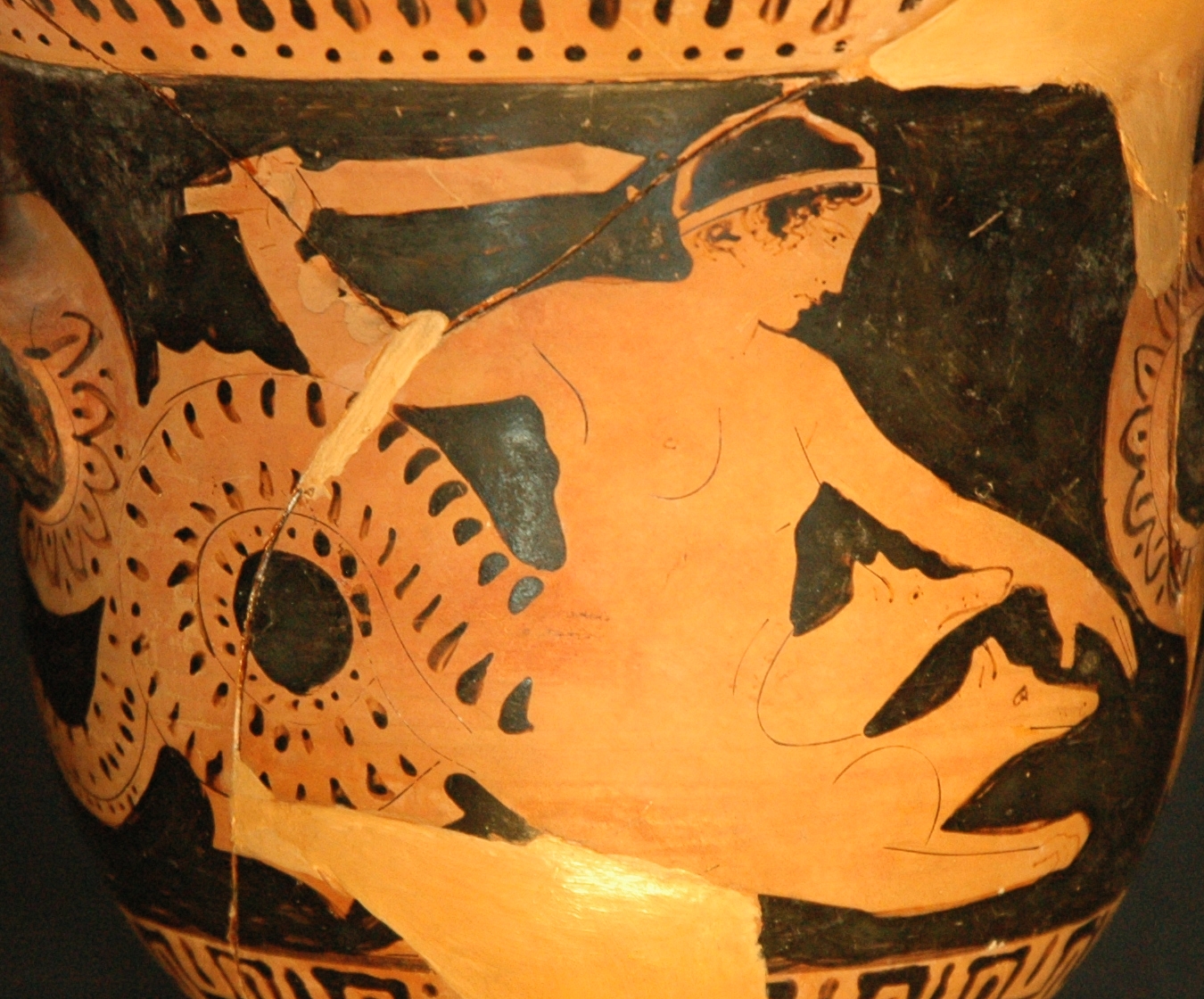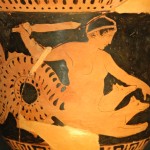

Museum Collection: Musée du Louvre, Paris, France
Catalogue Number: TBA
Beazley Archive Number: N/A
Ware: (Lucanian?) Red Figure
Shape: Krater
Painter: —
Date: ca 450 – 425 BC
Period: Classical
the names of two rocks between Italy and Sicily, and only a short distance from one another. In the midst of the one of these rocks which was nearest to Italy, there dwelt, according to Homer, Scylla, a daughter of Crataeis, a fearful monster, barking like a dog, with twelve feet, six long necks and mouths, each of which contained three rows of sharp teeth. The opposite rock, which was much lower, contained an immense fig-tree, under which there dwelt Charybdis, who thrice every day swallowed down the waters of the sea, and thrice threw them up again : both were formidable to the ships which had to pass between them (Hom. Od.xii. 73, &c., 235, &c.). Later traditions represent Scylla as a daughter of Phorcys or Phorbas, by Hecate Crataeis (Apollon. Rhod. iv. 828, &c., with the Scholiast), or by Lamia; while others make her a daughter of Triton, or Poseidon and Crataeis (Eustath.ad Hom. p. 1714), or of Typhon and Echidna (Hygin. Fab. praef.). Some, again, describe her as a monster with six heads of different animals, or with only three heads (Tzetz. ad Lycoph. 650 ; Eustath. l. c.).
“Skylla (Scylla), daughter of Krataiis (Crataeis, Of the Rocks) or Trienos (Three-Times) and Phorkos (Phorcus).”
SCYLLA GUARDIAN OF HADES
Virgil, Aeneid 6. 287 ff (trans. Fairclough) (Roman epic C1st B.C.) :
“Many monstrous forms besides of various beasts are stalled at the doors [of Hades], Centauri (Centaurs) and double-shaped Scyllae, and the hundredfold Briareus, and the beast of Lerna, hissing horribly, and the Chimaera armed with flame, Gorgones and Harpyiae (Harpies), and the shape of the three-bodied shade [Geryon].”
Statius, Thebaid 4. 536 ff (trans. Mozley) (Roman epic C1st A.D.) :
“Why should I tell thee of Erebus’ [Haides’] monsters, of Scyllae, and the empty rage of Centauri (Centaurs), and the Gigantes’ (Giants’) twisted chains of solid adamant, and the diminished shade of hundredfold Aegaeon?”
Statius, Silvae 5. 3. 260 ff (trans. Mozley) (Roman poetry C1st A.D.) :
“But do ye, O monarchs of the dead and thou, Ennean Juno [Persephone], if ye approve my prayer [provide a peaceful journey for the soul of my dead father] . . . let the warder of the gate [Kerberos, Cerberus] make no fierce barking, let distant vales conceal the Centauri and Hydra’s multitude and Scylla’s monstrous horde [other monsters appointed guardians of Haides after their deaths].”
Allusion – between Scylla and Charybdis
Having to confront one or the other of two
equally dangerous hazards. The allusion is to
Greek mythology and the Strait of Messina. Scylla
aroused the jealousy of the goddess Amphitrite by
attracting the amorous attentions of Amphitrite’s
husband, Poseidon. Transformed by Amphitrite
into a monster with six dogs’ heads, each with
three rows of teeth, Scylla made her home in a
cave in the Strait of Messina directly opposite the
abode of the equally horrifi c Charybdis, who was
the daughter of Poseidon and Gaea and had been
turned into a monster by Zeus. Any vessel that
passed between the two was likely to be attacked
and the sailors devoured; the more they tried to
evade one threat, the more likely they were to fall
prey to the other. In more prosaic terms, Scylla
was identifi ed as a vast promontory of rock, while
Charybdis was described as a whirl pool.
Louis considered which woman to choose, feeling himself
caught like a hapless seaman between Scylla and Charybdis.
Source and more info: http://www.theoi.com/Pontios/Skylla.html &
http://www.greenvalleyhs.org/library/Documents/Allusions.pdf






























